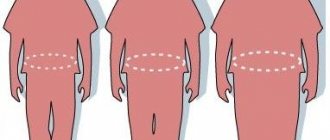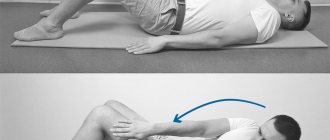Neither a fitness trainer nor a nutritionist can give you a definitive answer on how many calories are burned when running. There are many factors on which the consumption of these very units depends; for a correct calculation, all of them should be taken into account. All tables and graphs found on the Internet provide average values. They only give a general idea of the approximate figure, but in reality it can be several times more or less. This is why many runners find that their weight loss process is at a standstill. It seems that he did everything according to schedule, honestly worked on the hamburger he ate on the track, but the scale arrow does not deviate to the left...
To understand how many calories are burned by running in place, or any other type of it (interval, shuttle, jogging, long sprint, etc.), let's first understand what calories are and how they are burned during physical activity .
What is it and why is it needed?
BJU is a generally accepted abbreviation for the combination of “proteins, fats, carbohydrates.” Collectively, these substances are called nutrients. Nutrients are the main components of our body. Both the appearance and health of a person largely depend on them. Each of the nutrients has its own properties and role in our life. Let's look at them in more detail:
- Squirrels
. They form muscles, support immunity, and also promote cell growth. Proteins are found in eggs, meat, cheese, fish, legumes and other foods. However, in each case they are accompanied by different excipients, so it is not recommended to obtain proteins, for example, only from chicken meat. In addition, you need to ensure that your diet contains both animal and plant proteins. Although the latter contain fewer essential amino acids, they have an anti-sclerotic effect, that is, they normalize the functioning of blood vessels. - Fats
. They are secondary, but no less important sources of energy; they increase the elasticity of the walls of blood vessels, as a result of which the tissues receive more nutrients from the blood. Their deficiency in the body leads to liver and kidney diseases, fluid retention and skin problems. It is fats that affect the level of cholesterol in our blood, so their excess often causes atherosclerosis. Fats are contained in vegetable (sunflower, corn and other oils) and animal (meat, fish, butter) foods. The recommended ratio of vegetable and animal fats in the diet is 3:7. - Carbohydrates
. This is the primary source of energy. Nutritionists usually divide carbohydrates into simple (fast) and complex (slow). The first group includes monosaccharides and disaccharides. The most common example is table sugar, but simple carbohydrates are also found in fruits and sweets. They are called fast because of the speed of breakdown and absorption in the body. Their functions are regulation of blood sugar levels, nutrition of muscles and brain. And now about complex carbohydrates: they are found in pasta, cereals, vegetables and white bread; they take a long time to break down, thanks to which they saturate the body with energy and have virtually no effect on sugar levels. Excess carbohydrates can turn into fats, which again causes cholesterol levels to rise and atherosclerosis to develop. Excluding carbohydrates from the diet is one of the most popular diets: if they are lacking, the body will begin to use fat reserves as an energy source.
In order for nutrients to properly perform all of the above functions, they must be supplied in the right quantities and proportions. This is the purpose of calculating BZHU - to find out how many nutrients of each type need to be consumed to achieve a particular goal.
Can I Still Eat Good Food When Watching My Calories?
Certainly! The more important point is that not all calories are created equally. You can get 100 calories from potato chips and 100 calories from cucumber with hummus. And each of them will give +100 calories to your daily calorie intake. But cucumber and hummus will give you a much greater effect.
Eating low-calorie fruits and vegetables means that you can eat a lot of them and still get few calories and load up on healthy nutrients and vitamins that will help keep your body in good condition.
Plus! You'll cut back on processed foods and sugars, which can add fat cells and slow down your running speed. If your goal is to lose weight, well, you don't just have to restrict calories. Against! Be smart and focused on getting the most nutritionally dense, low-calorie foods you can.
And most importantly, try not to focus on calories. Watching calories and thinking about how much you consume can completely destroy the joy of eating and running.
Daily norm
Nutritionists have long calculated nutrient consumption standards. They allow you to find out what limits it is better not to go beyond when creating a diet, because serious deviations from the norm (which is often found in pseudo-effective diets) lead to the development of diseases and exhaustion of the body. So, every day a person needs to consume approximately:
- 1.5-2 g of protein per 1 kg of weight, the exact figure depends on the level of activity;
- 0.8-1.5 g of fat per 1 kg of weight;
- 2 g of carbohydrates per 1 kg of weight (athletes can increase this norm by 2 or more times).
However, these values are approximate. The exact norms depend not only on activity, but also on a person’s physical data and his goals (losing weight, staying in shape, gaining muscle mass).
What determines calorie consumption?
The running calorie burn calculator will give you average values that you can adjust if you know what calorie burn depends on:
- From your weight - the obese a person, the more energy he needs to train;
- From age - unfortunately, with age, metabolism slows down, the process of fat deposition occurs much faster, but its consumption, on the contrary, slows down;
- Depending on the type of running, the most energy-consuming are interval training, long-distance sprinting, and uphill running. Jogging or race walking are considered less intense physical activities, so they burn fewer calories.
Ratio of proteins, fats and carbohydrates
In addition to daily norms, the proportions of nutrients also help control the diet. Let's divide them into three types:
- For a healthy diet. The standard ratio is 3/3/4, that is, 30% of the diet consists of proteins and fats, and 40% of carbohydrates.
- For weight loss. To lose weight, you need to reduce the amount of fat you consume in favor of carbohydrates. So the latter should make up half of the diet, proteins - from 25 to 35%, and fats - no more than 30%.
- For gaining weight. In this case, you again need carbohydrates (workouts require a lot of energy) and proteins (muscles are made up of them). We get a proportion of 35/30/55. It is also noted that before gaining weight you need to make sure there is no excess fat. In other words, first we lose weight and burn fat, and then we build muscle.
Burning calories by walking how it works
To start walking and lose calories, you definitely need to buy comfortable shoes and clothes.
If a person experiences discomfort, then there is a chance that he will give up walking. Comfortable shoes and clothing also bring additional benefits:
- the mood rises;
- heat exchange is ensured, which will prevent you from freezing or getting wet;
- the risk of injury is reduced.
When walking has just begun, calories are not so important. You can’t lose weight instantly, so at the initial stage you just need to get into the rhythm and learn to enjoy the process itself. In this case, after some time the body itself will want to receive the usual load.
As a general rule, you need to walk for at least 2 hours, periodically changing the speed and terrain. But for an untrained, overweight person, it is better to start with small walks and increase the difficulty only when it does not cause strain.
Calculation formulas
Above, we determined what portion of our diet (in calories) should be made up of one or another nutrient.
The next step is to determine the total number of calories we should consume per day. You can find out your caloric intake using special calculators on the Internet. You just need to enter gender, weight, height, age and lifestyle in the appropriate lines and get an answer. However, you can do the calculations yourself. There are special formulas for this.
Mifflin-St. Geora counting formula
Developed in 2005 by a group of American nutritionists and has the following form:
- (10 x weight (kg) + 6.25 x height (cm) – 5 x age (g) + 5) x A - for men;
- (10 x weight (kg) + 6.25 x height (cm) – 5 x age (g) – 161) x A – for women.
For greater clarity, let’s take a closer look at the calculation process using this formula:
- Multiply the weight in kilograms by 10;
- Multiply height in centimeters by 6.25;
- Multiply the age in years by 5;
- We add the results of steps 1 and 2 and subtract the result of step 3 from the resulting amount;
- For men, we add 5 to the resulting number, for women, we subtract 161 from it;
- We multiply the result by coefficient A.
A is a coefficient expressing the level of human activity. It has 5 meanings:
- 1.2 - almost complete lack of activity. This includes people with a sedentary lifestyle who do not exercise.
- 1.375 – weak activity. This is either a sedentary lifestyle coupled with small workouts 1-3 times a week, or activities that require regular long walking.
- 1.55 – average activity. This coefficient is chosen by those who play sports 3-4 times a week for 30-60 minutes.
- 1.7 - high activity. This includes daily or almost daily training, or employment in construction, agriculture, etc.
- 1.9 - extreme activity. This includes athletes with repeated daily training sessions and people with long working hours, such as in coal mines.
Using this scheme, calculating the calorie level is recommended only for persons from 14 to 80 years old.
Harris-Benedict formula
Its first version appeared already in 1919, but 65 years later an adjustment took place and now the formula looks like this:
- (88.362 + (13.397 x weight (kg)) + (4.799 x height (cm)) - (5.677 x age (g))) * A - for men;
- (447.593 + (9.247 x weight (kg)) + (3.098 x height (cm)) - (4.330 x age (g))) * A - for women
The activity coefficient in this case is determined in exactly the same way.
FAQ
Still not sure how to use a calorie calculator for weight loss? Here are the answers to questions often asked by those who want to lose weight.
Can I eat whatever I want and still lose weight? This is a difficult question. You can eat anything and lose weight as long as you stay within a certain amount of calories. Theoretically, you can eat nothing but candy all day long and still lose weight. But it's better not to do this. Why? Because it will be quite difficult to stay in the desired calorie range if you do not eat nutritionally valuable foods. Healthy makes you feel strong, energetic and full. Eating empty calorie foods does not provide the body with the essential nutrients it needs to live a healthy, active life. And if you eat unhealthy foods, you'll likely just feel more and more hungry and end up overeating. Can I eat more if I exercise every day? If you factored exercise into the equation when using the calculator, then you can't eat more if you exercise. Your daily norm (the result of the calculator calculations) already takes into account additional physical activity. However, if you didn't include exercise when you did the calculations and then added exercise to your daily routine, you've increased your daily calorie deficit. If you don't eat enough calories to exercise, this will increase your deficit and you will lose weight faster. If you consume the same number of calories as you burn, your rate of weight loss will remain the same as indicated in the calculator results. Be careful, though, it's easy to eat more calories than you burned during your workouts. This leads to weight gain rather than weight loss. How do I calculate my daily calorie intake? There are many different ways to track your daily calorie intake. Many dieters use apps on their phones or websites like MyFitnessPal or LoseIt. These services allow you to enter the foods you eat, your serving size, and automatically calculate your daily calorie intake. There are also activity trackers, such as Fitbit, that help you track the number of calories you eat and burn during exercise. If you are not a fan of gadgets, use a regular notebook. Just write down the number of calories there, so you will have an adequate idea of it. Do I need to buy a diet program or go to training? If so, which program is the best? There is no “best” diet because each person is different and has their own lifestyle and needs. The diet that works best for you is the diet that you are able to stick to. For some, a self-created diet is best. But for some, the structured approach of a commercial weight loss program may work better. Ask yourself the key questions about your lifestyle (do you cook your own food? How long does it take you to find healthy food in stores? How much are you willing to spend on it?) and make a decision that suits your needs. Are all calories the same, or are some better than others? Although the total number of calories you consume is most important for weight loss, not all calories are created equal. The calories you get from nutritionally nutritious foods will help you feel fuller longer, provide energy for everyday activities, and improve your overall well-being. But what is healthy food? Most experts recommend setting the table as follows:
- A variety of colored vegetables such as lettuce, bell peppers, carrots and radishes. Experiment and you will definitely find vegetables to your liking.
- Lean meat, chicken or fish. Some also recommend red meat in moderation.
- Whole grains provide fiber to the body, including oatmeal, whole grain bread and crackers.
- Whole fruits are preferable to juices or snacks with pieces of fruit, and nuts, seeds and other sources of dietary fats are also helpful to quench your thirst, and drink water rather than sports drinks, sweetened teas or soda.
Instead of filling you up, empty calories are more likely to make you hungry, increase your desire to eat more, and may even make you tired.
What are empty calories? You can find them in processed foods that contain added sugars, trans fats, excess fat and calories. Candy, fast food, snacks, soda are all sources of empty calories. What if I use the calculator but the weight doesn't come off? There are many factors that contribute to weight loss success. If you don't start losing weight right away, it doesn't mean that nothing worked or that you did something wrong. It may take some more time for the weight to start coming off. Take a hard look at your eating and exercise habits to see if you need to make any changes to achieve your desired results. You may also have medical reasons that are preventing you from losing weight, so if you haven't lost weight for a long time, see your doctor. Your doctor may refer you to a qualified nutritionist for individual consultation, as well as advice on weight-loss medications or even surgical procedures to help you lose excess weight.
How to correctly calculate BZHU
The last step on the path to results is to convert calories into grams of individual nutrients. To do this we need to know the following:
- One gram of protein or carbohydrate contains 4 calories;
- One gram of fat contains 9 calories.
Thus, to find out your daily requirement of a particular nutrient in grams, you need to multiply the percentage of this nutrient in the diet by the caloric intake calculated above, and then divide this by the number of calories in one gram of the nutrient.
Now let's look at two examples of a full-fledged calculation of BZHU. Let a 30-year-old man, 180 cm tall and weighing 80 kg, spend about an hour every day to get to the office, and the same amount on the way back. He wants to switch to a healthy diet. Let's calculate the BZHU norms for his case. We have:
- Height - 180 cm;
- Weight - 80 kg;
- Age - 30 years;
- Activity - weak;
- The goal is to stay fit and switch to a healthy diet.
Based on the goal, we get a proportion of 3/3/4, that is, proteins and fats in the diet - 30% each, carbohydrates - 40%.
Activity corresponds to a coefficient of 1.375. Let's find out the caloric intake using the Mifflin-San Geor formula: (10 * 80 + 6.25 * 180 - 5 * 30 + 5) * 1.375 = 2447.5 kcal. Now we find out the amount of each of the nutrients: 2447.5 * 0.3 / 4 = 183.5 g - proteins; 2447.5 * 0.3 / 9 = 81.6 g - fat; 2447.5 * 0.4 / 4 = 244.8 g - carbohydrates. Let's consider another case. A 25-year-old girl, 165 cm tall and weighing 70 kg, wants to lose weight. Due to her employment in the mental sphere, her activity is as limited as possible. So we have:
- Height - 165 cm;
- Weight - 70 kg;
- Age - 25 years;
- Activity - absent;
- The goal is to lose weight.
She will consume 50% carbohydrates, 30% proteins and 20% fat.
The activity level gives a coefficient of 1.2. Let's calculate the caloric intake using the Harris-Benedict formula: (447.593 + 9.247 * 70 + 3.098 * 165 - 4.33 * 25) * 1.2 = 1797.3 kcal. Then the girl needs to consume: 1797.3 * 0.3 / 4 = 134.8 g - protein; 1797.3 * 0.2 / 9 = 40 g - fat; 1797.3 * 0.5 / 4 = 224.7 g - carbohydrates. Our calculator (new version) uses this formula:
The result of a 1200 calorie average consumption for gaining weight or maintaining weight:
- 1200 * 0.3 / 4 - proteins;
- 1200 * 0.3 / 9 - fat;
- 1200 * 0.4 / 4 - carbohydrates.
And for weight loss
- B: (1200*0.3)/4;
- F: (1200*0.2)/9;
- U: (1200*0.5)/4.
Using a weight loss calculator
Are you ready to try using our calculator? You will need to provide information about your age, gender, height, and current weight to get the number you need regarding how many calories you should consume. The calculator needs this data because these are factors that affect your metabolic index, or the number of calories your body needs to function. In general, men need more calories than women. Big people need more calories than small people, and young people need more calories than older people.
Are you ready to try using our calculator? You will need to provide information about your age, gender, height and current weight to get the calorie number you need. The calculator needs this data because these are factors that affect your metabolic index, or the number of calories your body needs to function. In general, men need to eat more calories than women. Big people need more calories than small people, and young people need more calories than older people.
You will also be asked how active you are. If you move a lot during the day, your body needs more fuel (in the form of calories). Try to answer the question about exercise and lifestyle as honestly as possible. If you misinterpret the numbers, you will not get an accurate result. If you're not sure how active you are, keep a diary of your fitness tracker for a week, allowing you to make a quick assessment.
Next you will be asked about your goals. At this stage it is important to think realistically. Your goal may be different from your desired or ideal weight. For example, you want to weigh 55 kilograms. But you've struggled with weight your whole life and have never weighed less than 70, in which case a goal of 120 is unlikely to be realistic. Try to set a mark that you think is achievable. Once you reach it, you can always install a new one.
Lastly, you will need to set a date by which you want to see your desired results. Don't forget that if you're trying to lose weight, a healthy rate is between 300 and 900 grams per week. If you want to gain weight, then this should be about half a kilogram per week.
Consequences of incorrect calculation of BZHU
Diet compilers most often neglect calculating BJU and take into account only the number of calories. As a result, the balance of substances in the human body is disrupted, which leads to:
- Constant hunger. A person has just eaten and is already dreaming about the next meal. This clearly indicates a lack of fats and carbohydrates.
- Slow weight loss. The body receives too few nutrients, so it adapts to save resources, so that fat is burned slowly.
- Constant volume. Weight decreases due to the removal of fluid from the body and a reduction in muscle mass. But the fat layers remain in place, so there are no visual changes.
- Disturbances in the functioning of hormones. This leads to mood swings, decreased performance, and sore skin, hair and nails.
- Health problems. Nausea, dizziness, tinnitus and even fainting - all this signals an unbalanced diet.
Thus, calculating BJU is an important procedure not only for losing weight or gaining muscle mass, but also for maintaining good physical shape and improving the health of the body. Nutrition in accordance with the calculations provides all the substances necessary for the body, which entails a lot of positive consequences.
Why do I need to watch my calorie intake?
Because no two runners are alike. If you look at professional long-distance runners, they burn about 700 calories a day during training.
- Different body weights
- Volume of oxygen consumed
- Fast muscle fiber volume
all this affects the athlete’s calorie expenditure.
But since excess calories lead to excess weight, which can lead to serious health problems (including sleep problems and heart disease), it's still important to have a basic understanding of the amount of calories you eat and burn.









